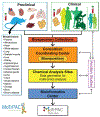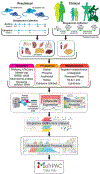Molecular Transducers of Physical Activity Consortium (MoTrPAC): Mapping the Dynamic Responses to Exercise
- PMID: 32589957
- PMCID: PMC8800485
- DOI: 10.1016/j.cell.2020.06.004
Molecular Transducers of Physical Activity Consortium (MoTrPAC): Mapping the Dynamic Responses to Exercise
Abstract
Exercise provides a robust physiological stimulus that evokes cross-talk among multiple tissues that when repeated regularly (i.e., training) improves physiological capacity, benefits numerous organ systems, and decreases the risk for premature mortality. However, a gap remains in identifying the detailed molecular signals induced by exercise that benefits health and prevents disease. The Molecular Transducers of Physical Activity Consortium (MoTrPAC) was established to address this gap and generate a molecular map of exercise. Preclinical and clinical studies will examine the systemic effects of endurance and resistance exercise across a range of ages and fitness levels by molecular probing of multiple tissues before and after acute and chronic exercise. From this multi-omic and bioinformatic analysis, a molecular map of exercise will be established. Altogether, MoTrPAC will provide a public database that is expected to enhance our understanding of the health benefits of exercise and to provide insight into how physical activity mitigates disease.
Copyright © 2020 Elsevier Inc. All rights reserved.
Figures




Similar articles
-
A multi-epigenomic map of endurance exercise training.Trends Genet. 2024 Sep;40(9):736-738. doi: 10.1016/j.tig.2024.06.005. Epub 2024 Jul 12. Trends Genet. 2024. PMID: 39003156
-
Multitissue responses to exercise: a MoTrPAC feasibility study.J Appl Physiol (1985). 2023 Aug 1;135(2):302-315. doi: 10.1152/japplphysiol.00210.2023. Epub 2023 Jun 15. J Appl Physiol (1985). 2023. Retraction in: J Appl Physiol (1985). 2023 Nov 1;135(5):1214. doi: 10.1152/japplphysiol.00210.2023_RET. PMID: 37318985 Free PMC article. Retracted.
-
Temporal dynamics of the multi-omic response to endurance exercise training.Nature. 2024 May;629(8010):174-183. doi: 10.1038/s41586-023-06877-w. Epub 2024 May 1. Nature. 2024. PMID: 38693412 Free PMC article.
-
The relationship between aerobic fitness and recovery from high intensity intermittent exercise.Sports Med. 2001;31(1):1-11. doi: 10.2165/00007256-200131010-00001. Sports Med. 2001. PMID: 11219498 Review.
-
The effect of endurance training on parameters of aerobic fitness.Sports Med. 2000 Jun;29(6):373-86. doi: 10.2165/00007256-200029060-00001. Sports Med. 2000. PMID: 10870864 Review.
Cited by
-
Time trajectories in the transcriptomic response to exercise - a meta-analysis.Nat Commun. 2021 Jun 9;12(1):3471. doi: 10.1038/s41467-021-23579-x. Nat Commun. 2021. PMID: 34108459 Free PMC article.
-
The Hidden Dangers of Sedentary Living: Insights into Molecular, Cellular, and Systemic Mechanisms.Int J Mol Sci. 2024 Oct 6;25(19):10757. doi: 10.3390/ijms251910757. Int J Mol Sci. 2024. PMID: 39409085 Free PMC article. Review.
-
Sexual dimorphism and the multi-omic response to exercise training in rat subcutaneous white adipose tissue.Nat Metab. 2024 May;6(5):963-979. doi: 10.1038/s42255-023-00959-9. Epub 2024 May 1. Nat Metab. 2024. PMID: 38693320 Free PMC article.
-
Age-Dependent Effects of Voluntary Wheel Running Exercise on Voiding Behavior and Potential Age-Related Molecular Mechanisms in Mice.J Gerontol A Biol Sci Med Sci. 2024 Jun 1;79(6):glae007. doi: 10.1093/gerona/glae007. J Gerontol A Biol Sci Med Sci. 2024. PMID: 38198648 Free PMC article.
-
Animal Models of Exercise and Cardiometabolic Disease.Circ Res. 2025 Jul 7;137(2):139-162. doi: 10.1161/CIRCRESAHA.124.325704. Epub 2025 Jul 3. Circ Res. 2025. PMID: 40608858 Review.
References
-
- Barrachina MN, Calderón-Cruz B, Fernandez-Rocca L, and García Á (2019). Application of Extracellular Vesicles Proteomics to Cardiovascular Disease: Guidelines, Data Analysis, and Future Perspectives. Proteomics 19, e1800247. - PubMed
-
- Barrès R, Yan J, Egan B, Treebak JT, Rasmussen M, Fritz T, Caidahl K, Krook A, O’Gorman DJ, and Zierath JR (2012). Acute exercise remodels promoter methylation in human skeletal muscle. Cell Metab. 15, 405–411. - PubMed
Publication types
MeSH terms
Grants and funding
- U01 AG055135/AG/NIA NIH HHS/United States
- U01 AR071158/AR/NIAMS NIH HHS/United States
- U01 AG055137/AG/NIA NIH HHS/United States
- U01 AR071130/AR/NIAMS NIH HHS/United States
- U01 AR071133/AR/NIAMS NIH HHS/United States
- U24 DK112340/DK/NIDDK NIH HHS/United States
- U24 EB023674/EB/NIBIB NIH HHS/United States
- U24 DK112341/DK/NIDDK NIH HHS/United States
- U24 DK112326/DK/NIDDK NIH HHS/United States
- U24 OD026629/OD/NIH HHS/United States
- U24 DK112342/DK/NIDDK NIH HHS/United States
- U24 DK112331/DK/NIDDK NIH HHS/United States
- U24 AR071113/AR/NIAMS NIH HHS/United States
- U01 AR071160/AR/NIAMS NIH HHS/United States
- U24 DK112348/DK/NIDDK NIH HHS/United States
- U24 OD036598/OD/NIH HHS/United States
- U01 AG055133/AG/NIA NIH HHS/United States
- P30 DK072476/DK/NIDDK NIH HHS/United States
- U01 AR071128/AR/NIAMS NIH HHS/United States
- P30 AG028740/AG/NIA NIH HHS/United States
- P30 DK036836/DK/NIDDK NIH HHS/United States
- U01 AR071124/AR/NIAMS NIH HHS/United States
- R01 GM070335/GM/NIGMS NIH HHS/United States
- U24 DK112349/DK/NIDDK NIH HHS/United States
- U01 AR071150/AR/NIAMS NIH HHS/United States
LinkOut - more resources
Full Text Sources
Other Literature Sources
Medical
Miscellaneous

